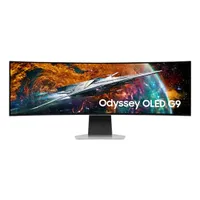TechRadar Verdict
As well as boasting a feature count most monitors can only dream about and spectacular gaming skills, the Samsung Odyssey OLED G8 is also the best 32-inch ‘TV’ there’s ever been.
Pros
- +
Class-leading screen protection features
- +
Stunning gaming performance up to 240Hz
- +
Jaw-dropping with video, too
- +
Gorgeous premium design
Cons
- -
No Dolby Vision support
- -
No NVIDIA G-Sync support
Why you can trust TechRadar
Editor's note
- Original review date: June 2024
Since John carried out his original review of the Samsung Odyssey OLED G8, Samsung has released a firmware update that gives the OLED G8 G-Sync compatibility and support (as of late June 2024). This is a welcome addition to the spec list and adds another string to the bow of the screen.
The rest of John's review below remains as originally published.

Samsung Odyssey OLED G8: Two-minute review
The Samsung Odyssey OLED G8 seems to want to be all things to all people. While it ticks pretty much every gaming box you’d expect a gaming monitor to tick (and then some), it also just so happens to be a stunning video display.
At the heart of its multifaceted talents is one of Samsung’s latest Quantum Dot OLED panels, here delivered in a flat 32-inch screen with a 16:9 aspect ratio. Samsung has managed to fit a full 4K resolution into this gaming monitor, backed up by support for a 240Hz refresh rate.
Where the OLED G8 really kicks up a gear, though, is with a trio of remarkable new features. First, a potent new screen filter enhances gaming immersion and contrast by somehow suppressing almost all reflections from your room. Second, pictures are driven by the same ultra-powerful processor deployed in Samsung’s flagship 8K TVs. Third, a new ultra-efficient cooling system has been built into the OLED G8’s OLED screen to protect it more effectively than any other OLED monitor from potential heat damage.
Add to these ground-breaking features insanely precise and vibrant gaming images and a video performance that humbles many premium TVs, and the OLED G8’s initially hefty-looking $1,499 / £1,099 price suddenly doesn’t look unreasonable at all.
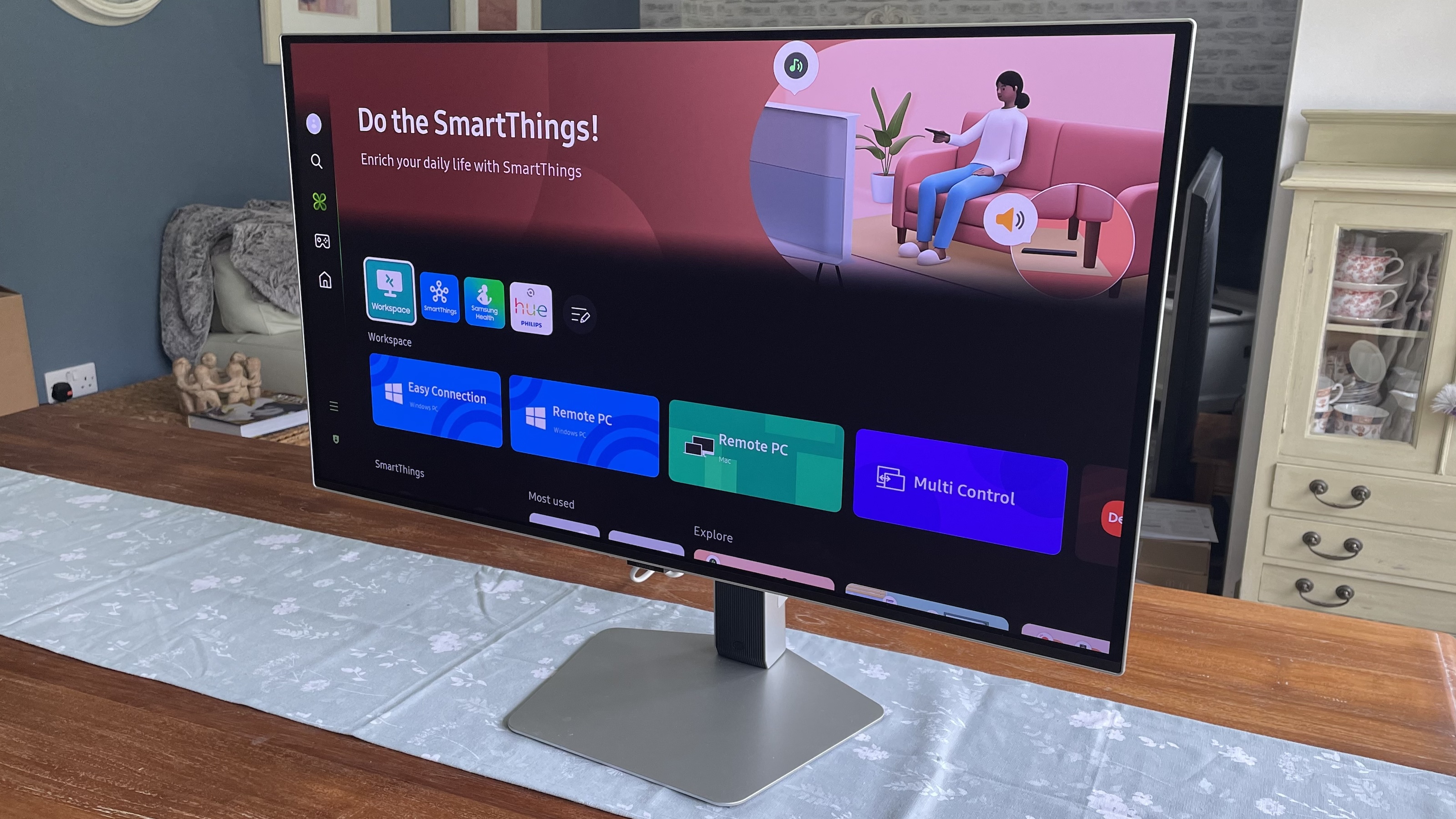
Samsung Odyssey OLED G8: Price and availability
- Price at $1,499 / £1,099.99
- Available in the US and UK
The Samsung Odyssey OLED G8 is available from the first week of July, priced at $1,499 in the US in the US and £1,099.99 in the UK. That represents a serious hunk of change in a world where 32-inch HDR-capable monitors such as the recently tested Gigabyte GS32QC can be had for $250 / £250, but the S32G80SD does one heck of a job of justifying that cost.
Sign up for breaking news, reviews, opinion, top tech deals, and more.
It’s built around a premium Quantum Dot type of OLED panel for starters, with all the innate picture quality advantages that it brings. Around that screen, moreover, Samsung has built a gorgeous-looking chassis packed with premium processing and hardware features the like of which, in some cases, the monitor world hasn’t seen before.
Samsung Odyssey OLED G8: Specs
Screen size | 32-inch OLED |
Aspect Ratio | 16:9 |
Resolution | 3840 x 2160 |
Refresh rate | 240Hz |
Brightness | 319cd/m2 |
Response time | 0.03ms |
Contrast ratio | 3806007:1 |
Inputs | 2 x HDMI 2.1 ports, 1 x DisplayPort 1.4, 2 x USB-C ports, 1 x USB-B port |
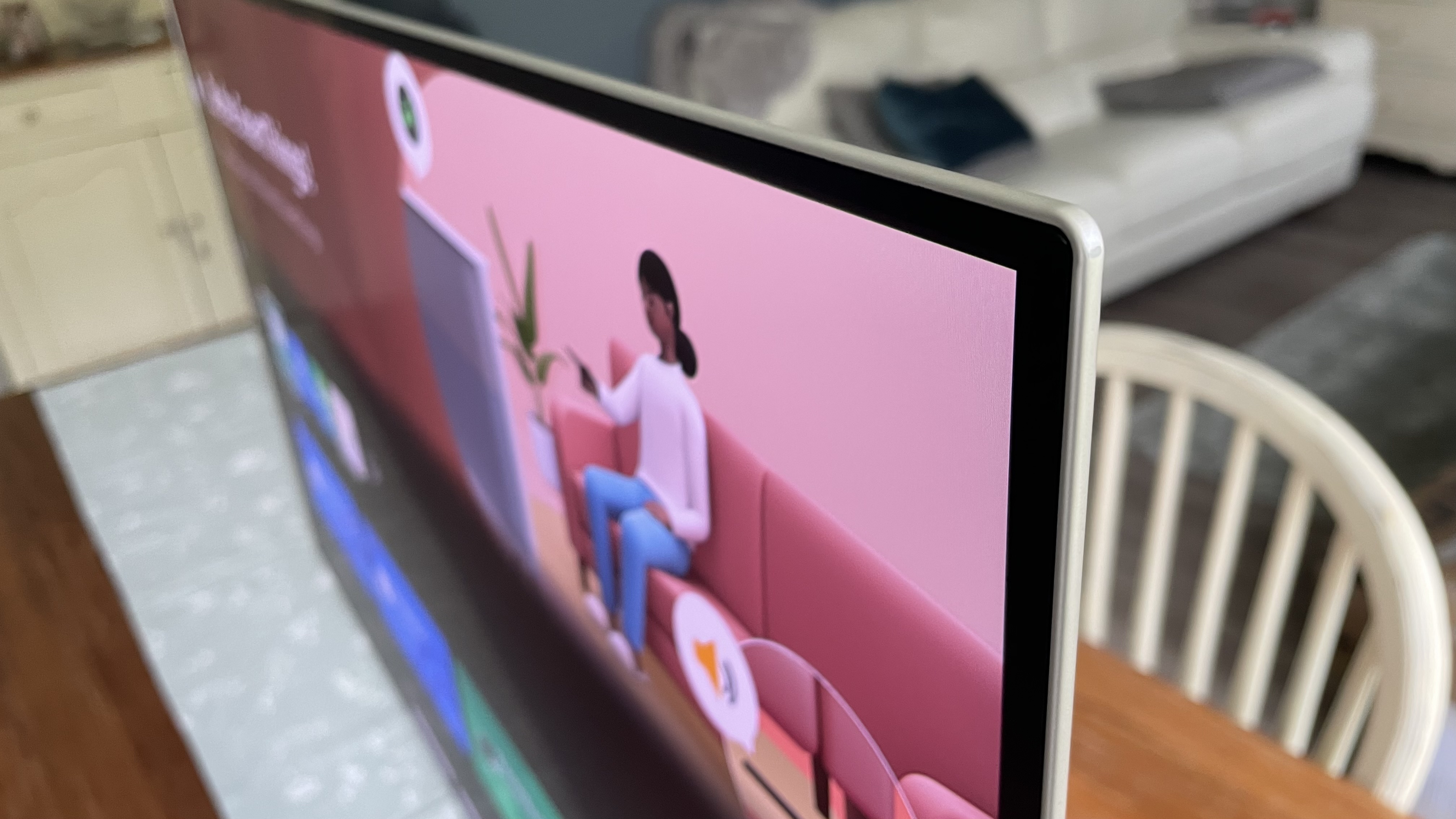
Samsung Odyssey OLED G8: Design
The OLED G8 looks and feels every inch a premium monitor. Build quality for the 32-inch, 16:9 flat screen is excellent, as a silvery metallic sheath wraps around from the outer edges of the bezel to cover the rear panel. This is replicated, too, over the handsome, heavy-duty hexagonal desktop foot. The rear panel is on-trend slim, but still finds room for some elegant arcs and curves, while the stand neck features a reflection-free corrugated black finish on its front edge and a cable tidy ‘ring’ on its rear.
Against such a subtle and refined design the appearance of a ring of colored LEDs around the stand attach point feels a bit garish at first. Thankfully you can turn this light show off if you wish - though actually, over time I grew to quite like the extra immersion it brings to gaming.
Impressively the OLED G8’s screen attaches to the neck and the neck attaches to the stand simply by twisting them together until they click into place. There’s not a screw in sight. The screen can tilt, swivel, pivot, and slide up and down on the stand, and there’s support for VESA mounting if you want to move away from the provided stand.
Connections are rather awkwardly positioned but impressively include two high bandwidth HDMI 2.1 ports as well as two USB-C ports, one USB-B port, and a DisplayPort (1.4). The OLED G8 ships with a small but ergonomic remote control that features a USB-C charge point on the bottom and, even better, a solar panel on its rear.
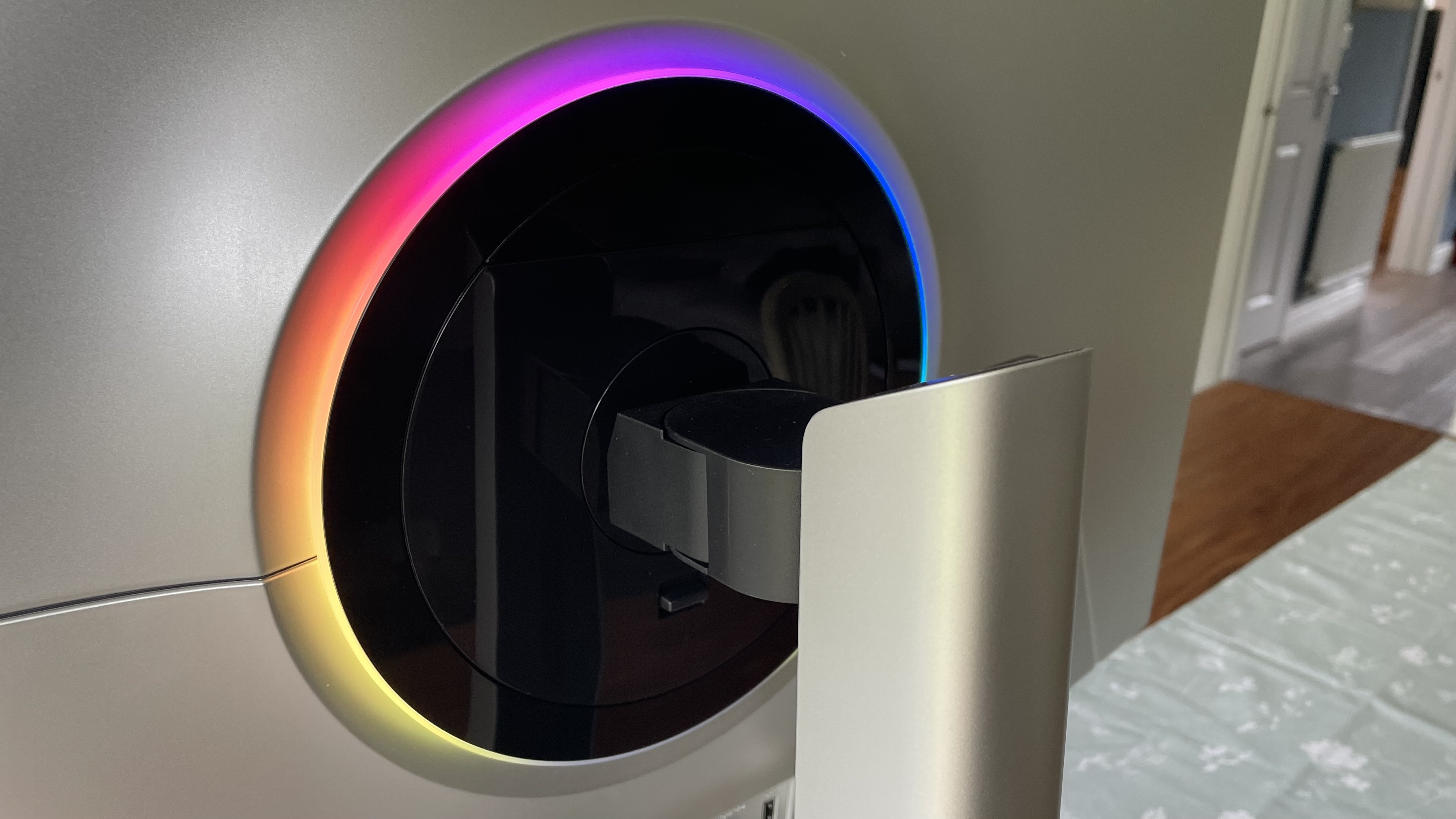
Samsung Odyssey OLED G8: Features
The Samsung Odyssey OLED G8’s epic roster of features kicks off with its use of one of Samsung’s new Quantum Dot OLED type of screens, which are already renowned for their remarkable color and contrast properties. What’s more, using a 16:9 aspect ratio has allowed Samsung to squeeze in a native 4K/UHD pixel count of 3840x2160.
The screen sports arguably the most effective anti-reflection filter I’ve ever seen on a monitor. General ambient light and mildly reflective objects in your room are rejected pretty much completely, while even harsh direct lights positioned directly opposite the screen are dispersed to a degree where you barely notice them even when you’re wandering around the dark underground environments in Shadow Of The Tomb Raider. There’s no overstating how much this reflection suppression enhances your immersion in whatever you’re watching or playing.
Anyone concerned about OLED’s susceptibility to screen burn-in should be very interested indeed in the OLED G8’s new Pulsating Heat Pipe cooling system. This condenses or evaporates coolant contained in tiny pipes that run behind the screen to control heat where necessary without any compromise to image brightness.
This potentially game-changing new OLED panel protection feature is joined by more traditional ones such as local dimming of logo/HUD elements, general ‘thermal modulation’ (brightness control), and a screen saver.

The OLED G8 is powered by what has to surely be the most powerful processor in the gaming monitor world. Samsung has essentially ported in an optimized version of the Neo Quantum 8 AI Gen 3 processor used in Samsung’s latest, highly acclaimed flagship 8K TVs. This might sound like overkill for a 4K monitor, but it really does make sense to apply to a gaming monitor a processor able to handle vast amounts of pixels, motion, color, and multi-window management (including simultaneous playback of different external AV sources) in real-time backed up by a knowledge base derived from no less than 512 separate neural networks.
The OLED G8 also carries the same Tizen operating system, with a few monitor-specific tweaks, used in Samsung’s latest gaming TVs. This means you get access to Samsung’s excellent Game Hub, which brings together your external game devices as well as streamed gaming services like Xbox Game Pass, NVidia GeForce Now, Boosteroid, and Utomic into one attractive and intelligently curated dedicated home screen. A ‘Daily+’ section of the Tizen interface also provides monitor-friendly features such as Easy PC setup, Remote PC support for PCs and Macs, Microsoft 365, and Samsung’s DeX system, while the home screen additionally gives you access to a great selection of video streaming apps. Netflix, Prime Video, YouTube, Disney+, and Apple TV, for instance, are all present and correct, as are many of the UK’s most popular terrestrial broadcaster catch-up platforms.
Almost every aspect of the OLED G8’s features can be controlled by voice commands using either the Bixby or Alexa voice recognition systems, often giving you an excellent shortcut without having to delve into the on-screen menu system.
Alongside the relatively unusual and premium features detailed so far, of course, are plenty of other modern gaming staples. There’s support for 240Hz, for instance, as well as 120Hz with native 4K feeds meaning it is firmly positioned to offer a premium PS5 monitor or Xbox Series X monitor solution. Variable refresh rates are supported in the core HDMI and AMD Freesync (though not NVIDIA G-Sync) flavors, while Auto Low Latency Mode switching (ALLM) is provided so that the TV can switch into a video or gaming mode automatically depending on what sort of content you’re playing on your console or PC.
You can also call up a dedicated Game Bar menu while gaming to get game signal information and fast access to gaming assistants such as an onscreen crosshair, and a couple of motion enhancement levels if you want to reduce judder at the cost of a little screen response time, and the option to raise the brightness level of dark areas without impacting the rest of the picture.
When it comes to HDR, finally, the OLED G8 supports the HDR10, HLG, and HDR10+ formats. There’s no support for the popular Dolby Vision system.
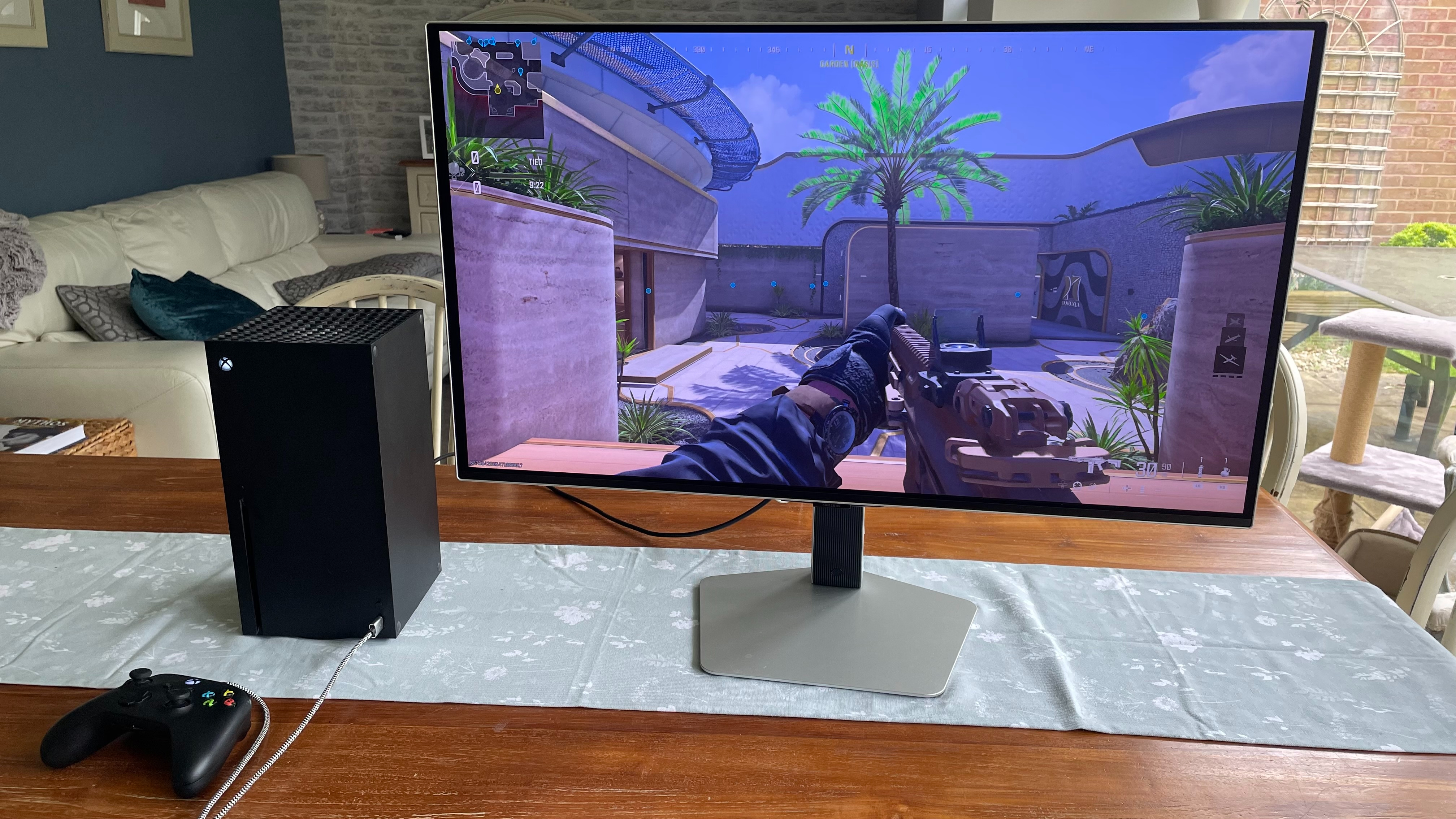
Samsung Odyssey OLED G8: Performance
The Odyssey OLED G8’s combination of a top-end OLED panel and ground-breaking new processing and features delivers images that are consistently jaw-dropping. And not just with games, either.
In fact, because it's so monumentally good with video compared with any other monitor I’ve seen, that’s where I’m going to start. With streamed video or external video sources, for starters, immaculately deep and clean black levels combine with pristine bright whites and rich colors without the slightest hint of compromise - even when the lightest and darkest parts of an HDR image are just a pixel apart.
Sharpness and detail are out of this world, as cramming a 4K pixel count into a 32-inch screen delivers a pixel pitch so small that high-quality 4K sources essentially just look like real life rather than something a screen is producing. The hugely powerful NQ8 AI Gen 3 processor delivers the most natural, detailed, and dense upscaling of sub-4K content I’ve ever seen on a monitor too. Please note, though, that while it’s fine with internal apps and connected video devices and consoles, the upscaling doesn’t work if the monitor is set to its PC mode.
Colors are gorgeously rich (bolstered by the pure RGB architecture of the QD-OLED panel), but also full of nuance and balance. They enjoy totally natural video tones, too - something most other monitors find very difficult to achieve.
Viewing angles are pretty much infinite, while the ability of the NQ8 AI processor to show even small objects like tennis or cricket balls without them phasing in and out of the picture is like nothing I’ve seen before on a monitor.
You have to be a little careful with some of the OLED G8’s video settings. I’d recommend avoiding the garish Dynamic preset, turning off the Auto Picture clarity mode, and choosing a custom setting with the Blur and Judder reduction elements set no higher than their level five. I’d also turn off Dynamic Tone Mapping, as it can cause some brightness instability with HDR sources.
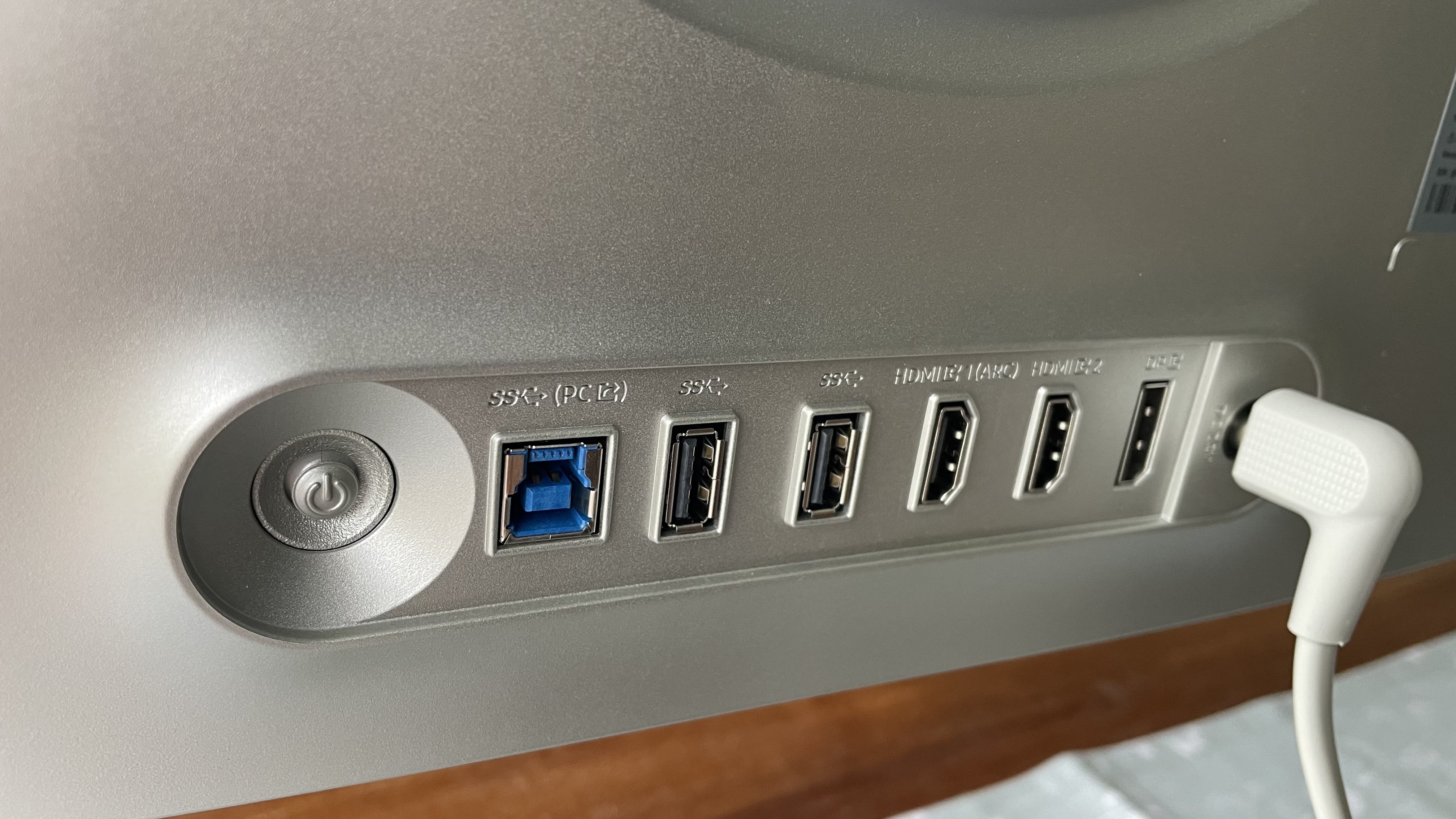
Set up correctly, though, the OLED G8’s video images are nothing short of a revelation.
While the OLED G8’s video mastery might be its biggest surprise, though, it is also, of course, a joyously brilliant gaming display. The sense of detail with native 4K games like Ori And The Will Of The Wisp delivered from an Xbox Series X is out of this world, for starters. In fact, the extra sense of the beauty of Ori’s world I got when running the game in 4K 120Hz on such an incredibly precise monitor actually felt a bit emotional!
Contributing to this sense of absolute precision is the OLED panel’s ability to control the light output of every individual pixel, which yields a gorgeously refined but also at times remarkably dynamic and intense sense of contrast. The range of colors the OLED G8 can cover (I measured 100% of sRGB and a whopping 99.2% of the DCI-P3 gamut) with almost infinite tonal subtlety plays a part in the immaculate finish of high-quality gaming images too.
If you’ve got a gaming PC capable of running 240Hz smoothly, you’ll find the OLED G8 more than up to the job of doing full justice to it. Unfortunately, neither this nor an incredibly fast screen response time of 0.03ms Grey to Grey could stop me sucking at Fortnite on PC - but at least getting hammered looked nicer.
Call Of Duty Modern Warfare 3 on PS5 looked and played better than I’ve ever experienced before on a monitor, too, while the beguiling world of Baldur’s Gate 3 on console and PC became even more enticing and rich looking - especially with the Game Motion Plus tool called in to smooth away any slight judder.
Games streamed from the many services the OLED G8’s Game Hub carries are all handled extremely slickly too, thanks to the monitor’s high-bandwidth Wi-Fi system and processing architecture expressly designed to minimize lag.
It’s tough to find anything negative to say about the OLED G8’s image performance. The Dynamic Tone Mapping option set to on by default in the Standard video preset can cause some distracting brightness instability with video sources, and I guess the image isn’t spectacularly bright in HDR or SDR (319 nits and 190 nits respectively on a 10% measurement window) mode. On the brightness point, though, the pinpoint precision of the OLED lighting, the reflection-free screen, a pretty high claimed typical brightness of 250 nits, and the impressive potential to hit nearly 1000 nits when showing small HDR highlights all add up to a typically quite rich and punchy HDR performance.
The OLED G8 partners its imperious pictures with a stereo 5W sound system. This is not, inevitably, in the same realm of brilliance as the picture quality is, but it does deliver game and film soundtracks with a decent sense of clarity and busyness, and without succumbing to distortion even at almost maximum volume. There isn’t much bass around, maximum volumes are limited and the sound lacks forward impact and impetus. But it’s perfectly acceptable, for the most part, for users who are likely to be sat quite close to the screen.
All in all, while not cheap by 32-inch monitor standards, the Samsung Odyssey OLED G8 does more than enough in the feature and, especially, image quality departments to justify its cost. While there are a couple of notable absentees in the form of Nvidia G-Sync and Dolby Vision support, the OLED G8 compensates for this with a raft of new unique cutting-edge performance enhancements and a remarkable ability to be a fantastic video screen as well as a brilliant and wonderfully immersive gaming monitor.
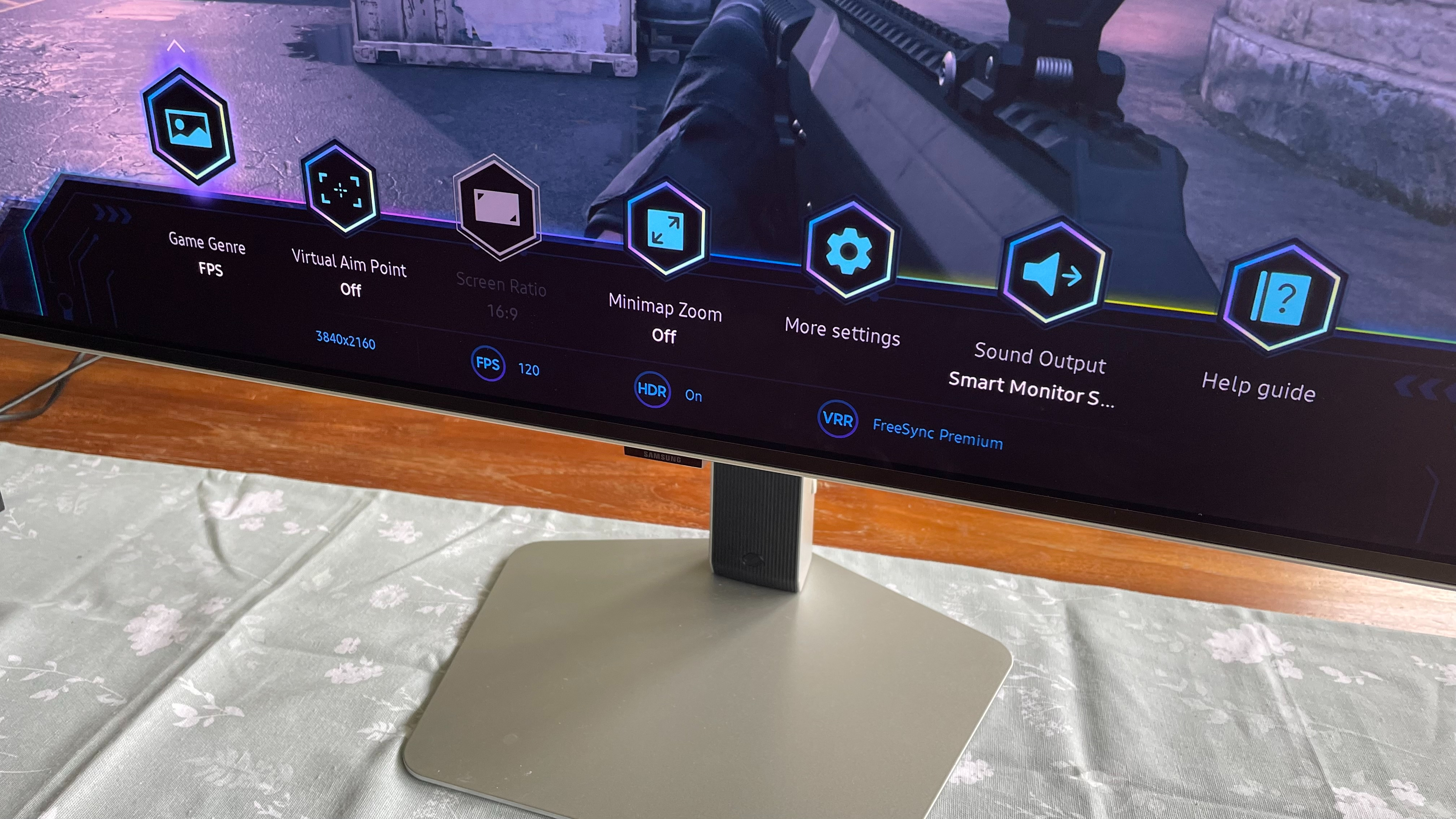
Should you buy the Samsung Odyssey OLED G8?
Buy it if...
You want a truly premium gaming experience
With its fast response time, incredibly precise images, and high-frequency rate support, the OLED G8 makes games look so good you don’t want to ever stop playing.
You also want a remarkably good video experience
As well as boasting more built-in video features than most monitors, the OLED G8 also produces hands down the best picture quality, especially with HDR sources, that I’ve ever seen from a monitor.
You’re not just a PC gamer
The OLED G8’s 16:9 ratio, native 4K resolution, processing power, input range, and built-in Tizen interface all make it a monitor that wants to do much more than just play PC games.
Don't buy it if...
You really love Dolby Vision
The OLED G8’s HDR support doesn’t include Dolby’s premium format which, like HDR10+ (which is supported), adds extra scene-by-scene image data to HDR feeds to help screens deliver better picture quality results.
You really love Nvidia G-Sync
While Samsung happily supports Nvidia’s GeForce Now game streaming platform, it doesn’t support the brand’s take on variable refresh rate technology.
You’re a die-hard PC-only gamer
If you’re not into consoles and don’t care about your monitor being able to do video, you might prefer a monitor with a more one-track PC mind. Maybe even one with an ultra-wide ratio.
Also consider
Not sold on the Samsung Odyssey OLED G8? Here are two good alternatives to consider.
| Row 0 - Cell 0 | Samsung Odyssey S32G80SD | Gigabyte M32UC | Samsung Odyssey OLED G9 |
Screen size | 32-inch OLED Flat | 32-inch VA LCD | 49-inch OLED |
Aspect Ratio | 16:9 | 16:9 | 32:9 |
Resolution | 3840 x 2160 | 3840 x 2160 | 5,120 x 1,440 |
Refresh rate | 240Hz | 144Hz (160Hz OC) | 240Hz |
Brightness | 319cd/m2 | 350 nits | 250 nits |
Response time | 0.03ms | 1ms | 0.03ms |
Contrast ratio | 3806007:1 | 3000 : 1 | 1,000,000:1 |
Inputs | 2 x HDMI 2.1 ports, 1 x Displayport 1.4, two USB C ports, one USB B port | 2 x HDMI 2.1 (support 4K 144Hz 4:4:4 @ DSC enabled or 4K 144Hz 4:2:0), 1 x Displayport 1.4, 1 x USB Type-C (Alternate Mode; Upstream port; Power Delivery up to 18W), 3 x USB 3.2 Downstream ports, 1 x USB 3.2 Upstream port, 1 x Earphone Jack | 1 x HDMI 2.1, 1 x Display port 1.4, 4 x USB Type-C |
Gigabyte M32UC
Although its picture quality isn’t as good for gaming or video, this is still a well-featured curved 16:9, 4K LCD monitor that costs barely half as much as the OLED G8.
Read our full Gigabyte M32UC review
Samsung Odyssey OLED G9
If you’ve got a serious PC rig and you’re not really so fussed about using your monitor with video or console sources, the Odyssey OLED G9 gives you Samsung’s QD OLED technology in a huge 49-inch ultra-wide aspect ratio.
Read our full Samsung Odyssey OLED G9 review
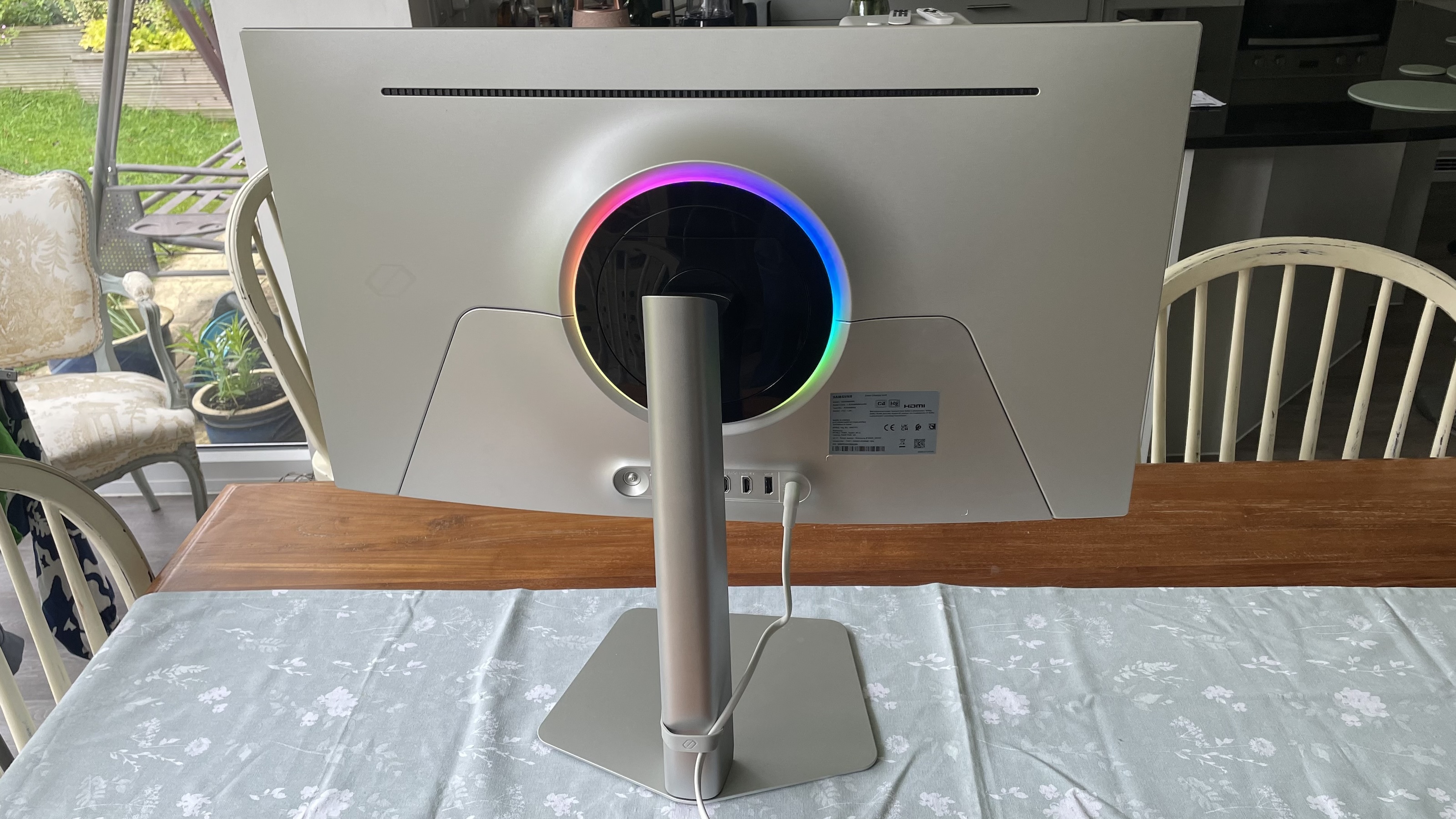
How I tested the Samsung Odyssey OLED G8
- Tested over 12 days
- Used for gaming, productivity, and media consumption
- Tested with plenty of games
Over the course of the 12 days I spent with the Samsung OLED G8 before writing this review, it was liberally used not just as a desktop display and gaming monitor, but also, once I realized how good it was with video, as a screen for watching streamed video from the likes of Netflix and Amazon Prime Video.
I’ve never spent anywhere near as much time watching video on a gaming monitor as I did with the OLED G8, in fact. But then I’ve never previously come across a video that’s so brilliant at showing video.
This didn’t prevent me from getting many (many!) hours of both work and play out of the monitor too, though. Calman software was used to measure the screen’s color capabilities and accuracy, along with a Murideo signal generator and Minolta colorimeter.
Games that found themselves in regular rotation were Fortnite and Call Of Duty: Modern Warfare 3 on a PC; Ori And The Will of The Wisp, Call Of Duty: Modern Warfare 3 and Baldur’s Gate 3 on Xbox Series X; and Fortnite and Elden Ring on PS5.
Tests were done for video, desktop, and gaming uses in both HDR and SDR modes.
First reviewed June 2024
John has been writing about home entertainment technology for more than two decades - an especially impressive feat considering he still claims to only be 35 years old (yeah, right). In that time he’s reviewed hundreds if not thousands of TVs, projectors and speakers, and spent frankly far too long sitting by himself in a dark room.


